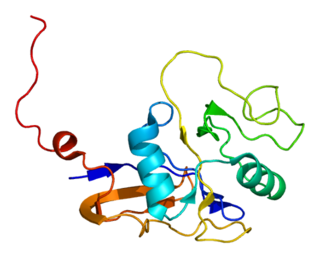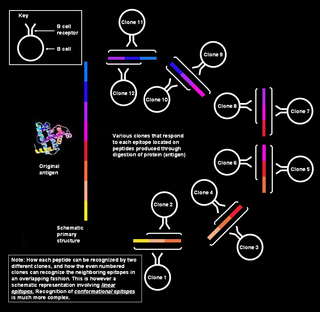Related Research Articles

A T cell is a type of lymphocyte. T cells are one of the important white blood cells of the immune system and play a central role in the adaptive immune response. T cells can be distinguished from other lymphocytes by the presence of a T-cell receptor (TCR) on their cell surface.

Duffy antigen/chemokine receptor (DARC), also known as Fy glycoprotein (FY) or CD234, is a protein that in humans is encoded by the ACKR1 gene.

Hyaluronic acid, also called hyaluronan, is an anionic, nonsulfated glycosaminoglycan distributed widely throughout connective, epithelial, and neural tissues. It is unique among glycosaminoglycans as it is non-sulfated, forms in the plasma membrane instead of the Golgi apparatus, and can be very large: human synovial HA averages about 7 million Da per molecule, or about 20,000 disaccharide monomers, while other sources mention 3–4 million Da.
Chimeric antigen receptor T cells are T cells that have been genetically engineered to produce an artificial T cell receptor for use in immunotherapy.

The CD44 antigen is a cell-surface glycoprotein involved in cell–cell interactions, cell adhesion and migration. In humans, the CD44 antigen is encoded by the CD44 gene on chromosome 11. CD44 has been referred to as HCAM, Pgp-1, Hermes antigen, lymphocyte homing receptor, ECM-III, and HUTCH-1.

Versican is a large extracellular matrix proteoglycan that is present in a variety of human tissues. It is encoded by the VCAN gene.

CD28 is one of the proteins expressed on T cells that provide co-stimulatory signals required for T cell activation and survival. T cell stimulation through CD28 in addition to the T-cell receptor (TCR) can provide a potent signal for the production of various interleukins.

MHC Class II molecules are a class of major histocompatibility complex (MHC) molecules normally found only on professional antigen-presenting cells such as dendritic cells, mononuclear phagocytes, some endothelial cells, thymic epithelial cells, and B cells. These cells are important in initiating immune responses.

Sialyl LewisX (sLeX) also known as cluster of differentiation 15s (CD15s) or stage-specific embryonic antigen 1 (SSEA-1), is a tetrasaccharide carbohydrate which is usually attached to O-glycans on the surface of cells. It is known to play a vital role in cell-to-cell recognition processes. It is also the means by which an egg attracts sperm; first, to stick to it, then bond with it and eventually form a zygote. The discovery of the essential role that this tetrasaccharide plays in the fertilization process was reported in August 2011.

Polyclonal B cell response is a natural mode of immune response exhibited by the adaptive immune system of mammals. It ensures that a single antigen is recognized and attacked through its overlapping parts, called epitopes, by multiple clones of B cell.
Siglecs(Sialic acid-binding immunoglobulin-type lectins) are cell surface proteins that bind sialic acid. They are found primarily on the surface of immune cells and are a subset of the I-type lectins. There are 14 different mammalian Siglecs, providing an array of different functions based on cell surface receptor-ligand interactions.

CD33 or Siglec-3 is a transmembrane receptor expressed on cells of myeloid lineage. It is usually considered myeloid-specific, but it can also be found on some lymphoid cells.

Glycophorin A , also known as GYPA, is a protein which in humans is encoded by the GYPA gene. GYPA has also recently been designated CD235a.

Hyaluronan-mediated motility receptor (HMMR), also known as RHAMM is a protein which in humans is encoded by the HMMR gene. RHAMM recently has been also designated CD168.

Hyaluronan synthase 1 is an enzyme that in humans is encoded by the HAS1 gene.

Lymphatic vessel endothelial hyaluronan receptor 1 (LYVE1), also known as extracellular link domain containing 1 (XLKD1) is a Link domain-containing hyaladherin, a protein capable of binding to hyaluronic acid (HA), homologous to CD44, the main HA receptor. In humans it is encoded by the LYVE1 gene.

Intracellular hyaluronan-binding protein 4 is a protein that in humans is encoded by the HABP4 gene.

Cell–cell recognition is a cell's ability to distinguish one type of neighboring cell from another. This phenomenon occurs when complementary molecules on opposing cell surfaces meet. A receptor on one cell surface binds to its specific ligand on a nearby cell, initiating a cascade of events which regulate cell behaviors ranging from simple adhesion to complex cellular differentiation. Like other cellular functions, cell-cell recognition is impacted by detrimental mutations in the genes and proteins involved and is subject to error. The biological events that unfold due to cell-cell recognition are important for animal development, microbiomes, and human medicine.

A Link domain or Link module, also known as Xlink domain, is a protein domain that binds to hyaluronic acid. It is important in blood cell migration and apoptosis. The link domain is found in some extracellular proteins in vertebrates such as the hyalectans. It appears to be involved in extracellular matrix assembly and stability, cell adhesion, and migration.
Pauline Johnson is an English immunologist and microbiologist at the University of British Columbia. Her research focuses on innate and adaptive immune mechanisms — in particular, the mobility of proteins in membranes, lymphocyte cell surface molecules, T cell signalling, leukocyte adhesion, and macrophages in lung inflammation.
References
- ↑ Telen MJ, Udani M, Washington MK, Levesque MC, Lloyd E, Rao N (March 1996). "A blood group-related polymorphism of CD44 abolishes a hyaluronan-binding consensus sequence without preventing hyaluronan binding". J. Biol. Chem. 271 (12): 7147–53. doi: 10.1074/jbc.271.12.7147 . PMID 8636151.
- ↑ "Red Cell Antigens - Fun Facts, Questions, Answers, Information". Fun Trivia. Archived from the original on 2015-03-12. Retrieved 2014-01-03.